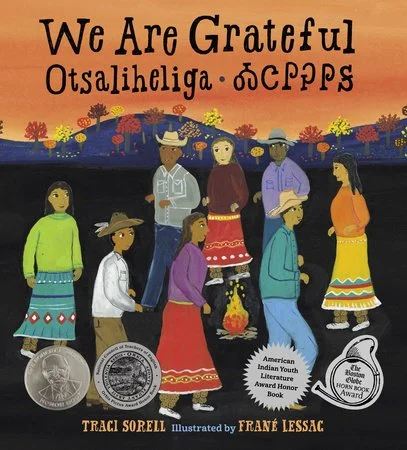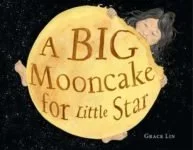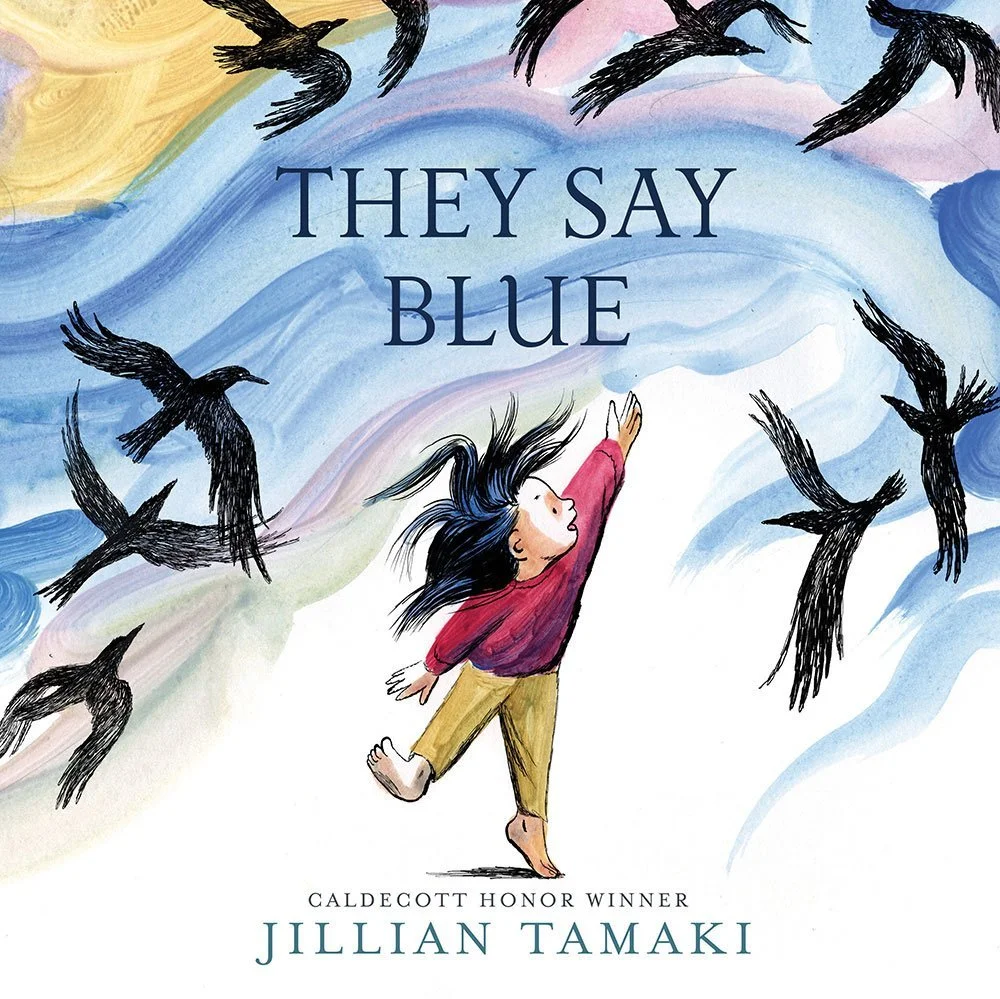Caldecott Club 2018: Session 2
(First posted December 5th, 2018)
Hi! I’m Miss Eti, one of the Youth & Teen Services librarians. I hosted our second Caldecott Club session on Thursday, November 29, here at the library. After the wonderful conversations we had during our first session, I was pumped to dive into a new set of amazing picture books and see what the kids noticed. During the Caldecott Club we look at amazing picture books and try to determine what makes them special and worthy of going to our Voting Party in January to win our Mock Caldecott. (If you’re new here and want to learn about our program, check out first blog post about Creating a Caldecott Community.)
The books we discussed in session 2 were:
We are Grateful: Otsaliheliga by Traci Sorell, illustrated by Frané Lessac
A Big Mooncake for Little Star by Grace Lin
Blue by Laura Vaccaro Seeger
They Say Blue by Jillian Tamaki
Picture Walk
Rather than doing a formal read aloud of each book, we did picture walks. I had a student volunteer help hold open the book for us, so we could all look at the pictures together – and make it easier for us to point out things they noticed. For the picture walk, we discussed each book’s visual features to examine the techniques the artists used and how they worked. Often I would prompt the group by asking them: What did you notice? How does this page make you feel? What makes this art distinguished?
We Are Grateful: Otsaliheliga
While I let the group choose the book we read first last time, I wanted to begin with a book that I think is truly distinct and exceptional, unlike anything I’ve ever seen. (Honestly, if it was up to me we’d spend an entire session just on this book alone; we almost did!) I was so excited to share We are Grateful: Otsaliheliga by Traci Sorell, illustrated by Frané Lessac. We began by learning how to pronounce Otsaliheliga (oh-jah-LEE-hay-le-gah) thanks to the amazing audio pronunciation guide “from Emilee Chavez, a Cherokee Nation citizen and language speaker” on the Charlesbridge website. It was really wonderful to repeat Otsaliheliga as we went through the seasons. Frané Lessac’s vibrant and colorful art engaged the kids & provoked their curiosity. They delighted in spotting the pileated woodpecker.
During my research, I learned from the Children’s Book Podcast with Matthew Winner interview with Traci Sorrell that the original art had an owl, but Traci shared that “that is not a messenger of good things for Cherokee people” and the art was changed. I told the kids this information and asked them what they thought about changing the art. One kid said, “The book is about being grateful, and the owl doesn’t fit into that.” Another kid remarked thinking about how Cherokee people would feel if there were an owl, that “they would be shocked.” Each moment in this beautiful book provided opportunities to expand our understanding. They asked thoughtful questions about the Cherokee syllabary and were eager to learn more about it thanks to the awesome back-matter.
S. asked about Traci Sorell’s inspiration for making this book. In the author’s note, she states: “I am grateful for the opportunity to provide a contemporary view of Cherokee culture in this book. From my childhood to today there have been few books that show present-day Cherokee children and families. Most have focused on our traditional stories or historical figures or events. Other books have misrepresented culture or perpetuated stereotypes… Many of us still observe the ancestral and ceremonial ways of life. We also live and work in the modern non-Cherokee world…”
I am grateful for the amazing back-matter to help me answer the many questions our kids asked. This book was also a great conversation starter that let us know that we need to know more. The intricate details in the illustrations continued to engage our group. R. noticed that the leaves looked like fingerprints in the trees. She also noticed the girl in purple during winter feeding her dog at the table. At the end of the book, D. remarked that she liked how the book began and ended the same way, with the family surrounded by the four seasons. As we closed our discussion of We are Grateful: Otsaliheliga and played the book trailer, something was still lingering in D.’s mind. She talked about how her expectations of the book were different than what she expected, alluding to other stories of Native people that depict them in tales of long ago. She said: “Sometimes the stories are not what’s really happening” and “Sometimes what we’re told is not true.”
This is the power of a picture book.
A Big Mooncake for Little Star by Grace Lin
We then turned our attention to A Big Mooncake for Little Star by Grace Lin. I drew their attention to the dedication to Grace Lin’s daughter, Hazel, and told them the origin story of the book with Grace Lin and her daughter celebrating the Moon Festival with mooncakes. (You can learn more about the story here. I also recommend watching this video where Grace shares her inspiration behind A Big Mooncake for Little Star.) Our group noticed the little details in the illustrations especially the body language and facial expressions. They appreciated the symmetry of the mooncake and Little Star in half circles across from each other. It was a lovely moment when they connected with the crumbs as stars, suspending their disbelief and entering the world of story. They noticed when Little Star returns to bed that she has no intention of sleeping based on the way she’s lying on her bed. These subtle differences really caught their eye. They were wowed by the dramatic moment when the phases of the moon are revealed, which led me to pause and show them the case cover secret. (I learned from Mr. Schu, librarian and Ambassador of School Libraries for Scholastic Book Fairs, to always check for a case cover secret.) We then turned to examine Little Star and her mother’s body language and expressions that reveal the deep love between them. At the end of looking at A Mooncake for Little Star, D. said, “You’re making me feel like I want to pick all the books.” Mission accomplished.
Blue by Laura Vaccaro Seeger
Next, we looked at Blue by Laura Vaccaro Seeger with an ice-breaker asking the kids to tell me how many kind of blue there are, which ranged from 3 to 17. They were thoroughly impressed by the die-cuts in the narrative, with one participant, M., trying to find the connections between each of then as they become new things. The group also noticed the baby blanket (and eventual bandana) in the pictures as the boy and his dog grow. (I guess this is a good time for a spoiler alert.) I told the group that this book causes me all sorts of feelings. Honestly, I tear up every time I get to the True Blue page. When we got to the Old Blue, I asked the group about the dog. One said he looks sad. M. asked, “Is he dying?” and I answered honestly. Yes, he is. Sob. When I asked the group how they felt looking at the True Blue page, R. blew me away with her answer. She said, “I kind of feel happy. They’ve had such a good life.” Such wisdom comes from young people. I was able to share Laura’s story of loss with them, working on painting the True Blue spread while her own dog Copper became ill and passed away. According to her interview with Julie Danielson on the Seven Important Things Before Breakfast blog, “The timing was remarkable, and the last few spreads were painted while my own tears dripped upon the canvas. Writing Blue, as it turns out, explored my own loyalty and sadness — in real time.” And of course, when I told the children this, they instantly went to seek out evidence of tears on the True Blue spread.
They Say Blue by Jillian Tamaki
With our time quickly coming to an end, we swiftly picture walked through They say Blue by Jillian Tamaki. I began by showing them the case cover secret which impressed them very much. Like the narrator wondering about the world around her, our group had many questions while looking through this book. They noticed the comic-like repetition of the girl moving across the page to show her in motion, changing and growing. They saw the similar textures and styles used for different things in nature. My favorite spread definitely is the winter to spring transformation, especially right now as winter is just beginning. As we finished reading the book, they also noticed on the cover that Jillian Tamaki had received a Caldecott Honor previously, noticing those little details that open up even more conversations.
VOTING!
After we had walked through each book in a whirlwind of color and conversation, we were ready to ballot. Each child received a paper ballot to select their top 2 choices (the first place book got 3 points, the second place book got 2 points). I asked for a helper at the beginning to help tally the results on our new fancy whiteboard. The top 2 books then are the winners of our session and go on the Voting Party on January 10.
And the Session 2 Winners Are….
A Big Mooncake for Little Star by Grace Lin
Blue by Laura Vaccaro Seeger
Join Us Next Time!
If you know a young person in 1st-8th grade who is interested in joining us, please register for our next Caldecott Club program on December 6 at 3:30-4:30. You don’t need a library card to sign up, but you do need a love of books & conversation!
Since you’ve spent all this time reading this post, I’ll even let you know which books we’ll be discussing:
The Day You Begin by Jacqueline Woodson, illustrated by Rafael López
What If… by Samantha Berger, illustrated by Mike Curato
This is the Nest that Robin Built by Denise Fleming
The Stuff of Stars by Marion Dane Bauer, illustrated by Ekua Holmes
Thanks for sticking all the way through this post… hope to see you next time!
– Eti
Resources
A librarian always provides her resources – here are a series of resources I found while preparing for this program that you may want to check out:
We are Grateful: Otsaliheliga by Traci Sorell, illustrated by Frané Lessac
Highly recommended: We Are Grateful/Otsaliheliga, by Traci Sorell from American Indians in Children’s Literature by Dr. Debbie Reese
The Children’s Book Podcast with Matthew Winner interview with Traci Sorell
Book Trailer (created by Frané Lessac)
Publisher Resources including audio pronunciations & teaching guide
Charlesbrige Unplugged: Traci Sorell
Read.Watch.Read. Mr. Schu’s interview with Traci Sorell
New Voice: Traci Sorell on We Are Grateful: Otsaliheliga by Cynthia Leitich Smith (Cynsations)
A Big Mooncake for Little Star by Grace Lin
Book Chat with the Illustrator: Grace Lin on A BIG MOONCAKE FOR LITTLE STAR
All the Wonders Cover Reveal and Interview
A Big Mooncake for Little Star Activities (Curious City DPW)
Behind A Big Mooncake for Little Star
PictureBooking Podcast with Grace Lin
Blue by Laura Vaccaro Seeger
Seven Important Things Before Breakfast interview with Laura Vaccaro Seeger
They say Blue by Jillian Tamaki
Jillian Tamaki Talks with Roger



